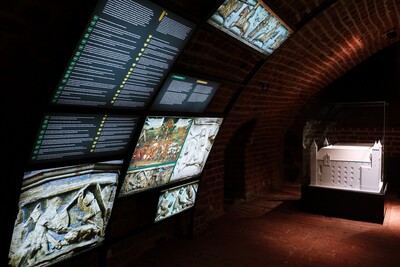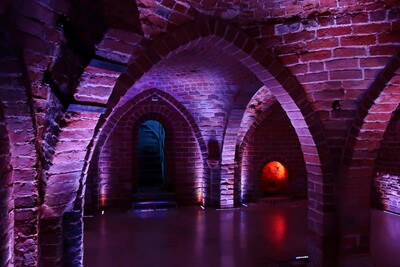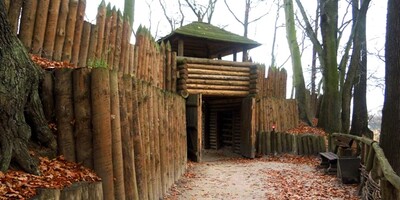The attractiveness of the "Blue Lamb" lies both in the exhibitions and in the interior itself. This branch of the Archaeological Museum in Gdańsk functions in a historic granary, the history of which dates back to the 16th century. Visitors can derive pleasure not only from viewing archaeological exhibitions, but also from walking around the unique facility. Elements of the structure resemble the former, original function of the granary. It is worth looking around as you walk between the exhibition halls.
Chmielna Street, where the "Blue Lamb" is located, is the main road on the Granary Island. This region of Gdańsk is interesting for at least two reasons: firstly, it has a fascinating history, and secondly, it is undergoing a dynamic revitalization, which changes the image of the island from year to year. The Blue Lamb perfectly combines the past with modernity: it tells the history of the port city through exhibitions in a renovated granary.
History of the granary
Originally, it was a Gothic brick building with access from Chmielna street and the Motława waterfront. The inventory from 1620 stated the width of the warehouse: 48 feet. Interestingly, it has not changed to this day.
In the sources from 1631, the German name appears for the first time: "Blaue Lamm", that is, the "Blue Lamb". Over the centuries, another name has also appeared, which was probably created as a result of a spelling mistake: "Blaue Löwe", meaning "Blue Lion".
In 1779, the granary was rebuilt using a new type of brick, the so-called "Dutch". The gable walls (triangular walls crowning the building) from the street and waterfront were built. The new structure consisted of a series of wooden ceilings, creating as many as seven storeys for the storage of goods.
Grain was stored in the granary and transported inside through wide gates. Three such gates on the ground floor were built from the river side and - exactly opposite - from the street side. Thanks to this, the unloading of goods was smooth, and the simultaneous work of many porters - collision-free. Loads were lifted to the upper levels with the help of special internal lifts. The attendants of the granary could only get there by ladder, steep stairs. On the other hand, there were holes in the floors for pouring dried grain onto the lower floors.
In the nineteenth century, an additional elevator was attached to the river side, the remains of which are visible on the western facade of the building until now. In the 20th century, a brick staircase was added to the north wall, connecting all floors.
During the siege of the city by the Russian army in October 1813, the granary was destroyed. However, it was rebuilt. Its owner in 1854 was Karol Wilhelm Uphagen - the great-grandson of Jan Uphagen, the owner of the famous tenement house at 12 Długa Street.
After the bombing of Gdańsk by the Soviet army in 1945, the "Blue Lamb" granary remained the only historic storage facility on the Granary Island, in which not only the facade, i.e. the front wall of the building, but also the interior - entablature and ceiling structure have been preserved.
In the post-war period, the granary was used as a herb warehouse by the Herbapol company. Then, for many years, it was vacant.
Despite the fact that the building was placed under conservation protection in 1967, no conservation or renovation works were carried out for a long time. The condition of the granary gradually deteriorated. The ceilings slowly collapsed, and they were temporarily supported with new pillars. As a result of a lightning strike, the roof truss (wooden skeleton of the roof) burned down, and the interior - unprotected against unfavorable weather conditions - was gradually damp and molded.
The Archaeological Museum in Gdańsk took the granary under institutional care in 1995. At that time, the priority was to save the historic building from destruction. Comprehensive conservation protection required large financial outlays, therefore activities had to be carefully planned and spread over time.
In the years 1995–2008, research and design work was carried out, the foundations of the granary were reinforced, the wooden load-bearing structure of the building, the roof truss and the roof covering were repaired, and the brick exterior facades were restored. The interior of the granary was adapted to the museum. The needs of people with disabilities were also taken care of.
| Day of the week | Opening hours | ||
|---|---|---|---|
| Tuesday | 08:30 - 16:00 | ||
| Wednesday | 08:30 - 16:00 | ||
| Thursday | 08:30 - 16:00 | ||
| Friday | 08:30 - 16:00 | ||
| Saturday | 09:00 - 17:00 | ||
| Sunday | 09:00 - 17:00 | ||
| Holidays | Opening hours |
|---|---|
| 2025.04.20 (Sunday) | x |
| 2025.04.21 (Monday) | x |
| 2025.05.01 (Thursday) | x |
| 2025.05.03 (Saturday) | x |
| 2025.06.19 (Thursday) | x |
| 2025.08.15 (Friday) | x |
| 2025.11.01 (Saturday) | x |
| 2025.11.11 (Tuesday) | x |
| 2025.12.25 (Thursday) | x |
| 2025.12.26 (Friday) | x |
| Tickets | ||
|---|---|---|
| normal | 14.00 PLN | |
| reduced | 10.00 PLN | |
| family | 30.00 PLN | maksymalnie 5 osób (2 osoby dorosłe i 1–3 dzieci) |
| children free of charge up to the age of 7 |
| when? | name | where? | about what? | for free | for children | |
|---|---|---|---|---|---|---|
 | Gniew. The Town of the Route of Great History Permanent exhibition | The castle in Gniew pl. Zamkowy 2 83-140 Gniew Pomorskie | archeology, city, utility items, weapons and militaria | yes | ||
 | The oldest history of Kępa Dominikańska Permanent exhibition | Romanesque Cellar pl. Dominikański 1 80-844 Gdańsk Pomorskie | archeology, city | |||
 | Gdańsk w świecie Hanzy Permanent exhibition | The "Blue Lamb" granary ul. Chmielna 53 80-748 Gdańsk Pomorskie | archeology, city, medicine, numismatic items, toys, utility items | yes | ||
 | Wyspa Spichrzów w Gdańsku Permanent exhibition | The "Blue Lamb" granary ul. Chmielna 53 80-748 Gdańsk Pomorskie | archeology, documents | yes | ||
 | Średniowieczna uliczka hanzeatycka Permanent exhibition | The "Blue Lamb" granary ul. Chmielna 53 80-748 Gdańsk Pomorskie | archeology, city, interiors and everyday life | yes | ||
 | Miasto pod miastem Permanent exhibition | The "Blue Lamb" granary ul. Chmielna 53 80-748 Gdańsk Pomorskie | anthropology, archeology | yes | ||
 | Grodzisko w Sopocie Permanent exhibition | Sopot „Stronghold” ul. Haffnera 63 81-715 Sopot Pomorskie | archeology, city, crafts, interiors and everyday life, martyrology, utility items, weapons and militaria | yes | yes |